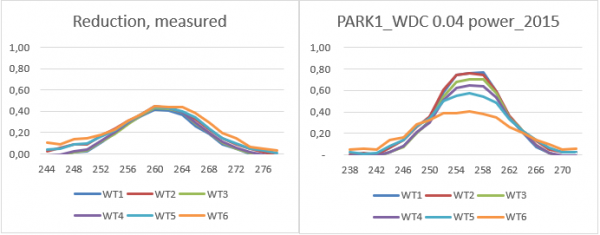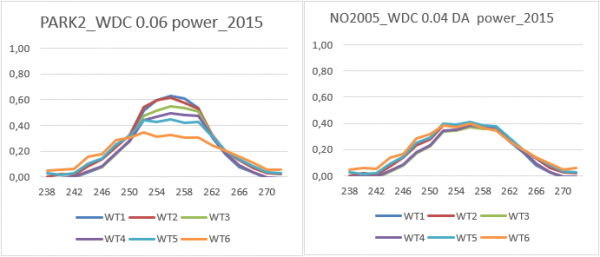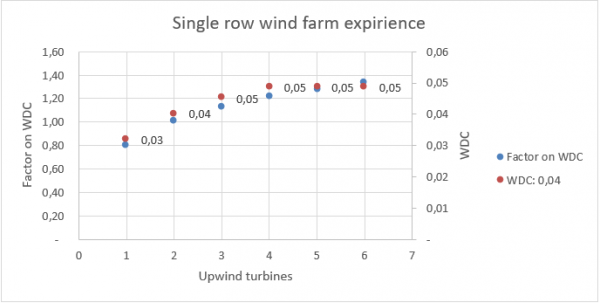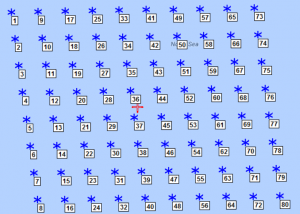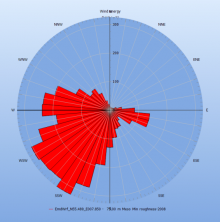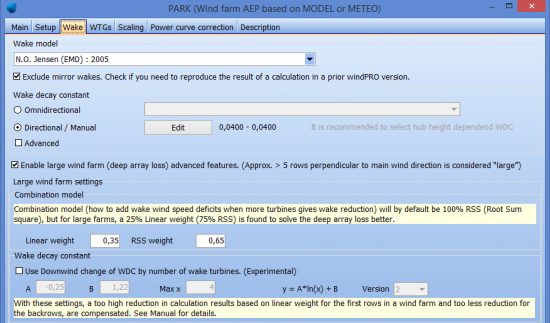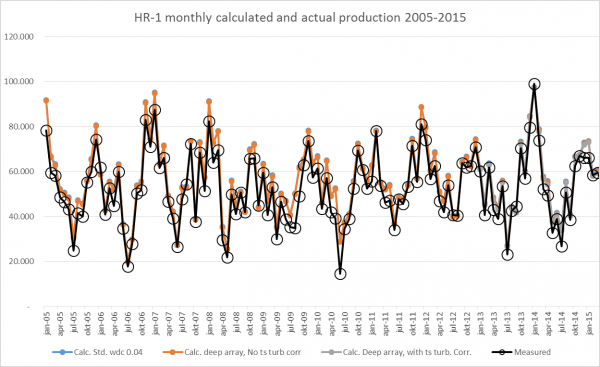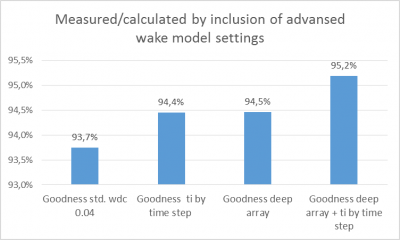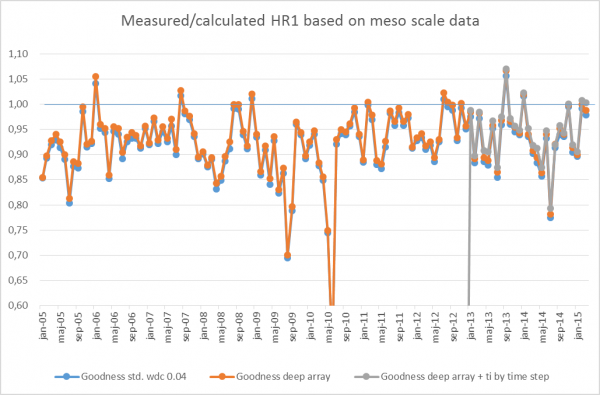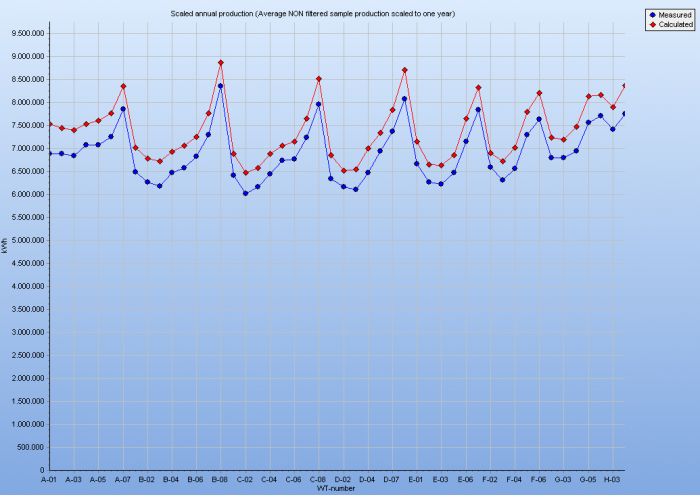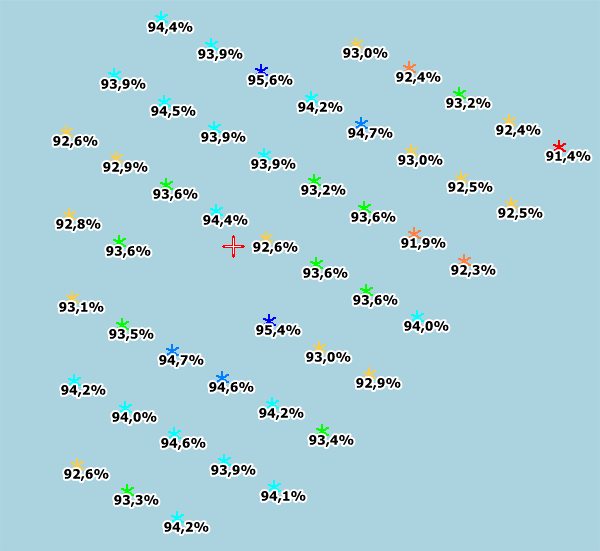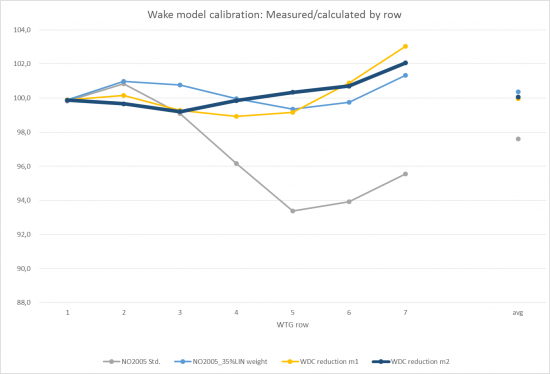Wakemodell-Validierungstests (Englisch)
Zur deutschen Hauptseite | Alle deutschsprachigen Seiten
Wake model tests
Some of the tests presented in this chapter has the purpose to illustrate how so called "Deep array settings" perform. In the manual chapter is concluded that deep array effects not seem the right naming, it is more a question of using the correct Turbulence controlled WDC. But still, for tuning wake models in post construction evaluations, the so called Deep Array (DA) effects still are relevant.
The first presented test case includes the new "PARK2", a N.O.Jensen variant included in WAsP 12.
Single row versus multiple row wind farms
A special problem to pay attention to is the single row vs multiple row projects. For single row projects, the wake models tend to estimate too high wake losses for backrows. The simple explanation is that fresh wind is feed in from the sides along the row. It is then typically seen that the back turbines have similar loss to the first wake turbine, where the models increase losses with number of upwind turbines. An example is illustrated below:
Measured left, calculated reductions by PARK1 (org. N.O.Jensen) right.
WTG 6 is the upwind turbine, with just 1 wake turbine in front (WTG7). Note the measurements show same reductions (Power%) for all 6 wake turbines, slightly higher for first wake turbine.
Calculations show essentially larger decrease in centre angles and by number of upwind turbines.
Calculated reductions by PARK2 left and by NO2005 with DA
With PARK2 it looks better, but the only real way to solve the single row calculation problem in this example is to increase WDC by number of upwind turbines (Deep Array (DA) settings).
In the calibrated version above to the right, the WDC change by upwind turbines are set to:
This result in following:
Factor on WDC and thereby increased WDC by upwind turbines.
As seen the WDC will be 0.03 for the first wake turbine, gradually increasing to 0.5, which is the upper limit after 4 upwind turbines. This work for single row projects (offshore for the mentioned values), where numerous other are tested, NOT for multiple row projects!
Horns rev 1, Danish Offshore project
A more comprehensive test of the wake models, especially with deep array settings, has been performed on the Horns Rev 1 wind farm, where EMD has access to wind measurements as well as production data at a 10-minute level for one year. A calculation was set up and data loaded in the Performance Check module for detailed filtering and evaluations of the measurements against calculations on different aggregation levels. Note the deep array settings are only available for the time-step based PARK calculation, for which only the NO2005 model is available.
Image: Wind farm layout and the direction distribution of energy
Note the turbine orientations give the densest spacing in north, east, south and west sectors. The results are evaluated in 30-degree sectors, but calculated in 1-degree steps. The first is shown for the 360 degree calculation, meaning a full year with all data.
For the total wind farm, with 360 degrees and all wind speeds, the wake loss is calculated as 10.8% with the original N.O.Jensen model, exactly as measured, but with smaller deviations by turbine row. The "measured" wake losses are found by calculating with 1 year of 10-minute data and finding the ratios of measured/calculated as averages for all non-error time stamps by use of the windPRO Performance Check module. Based on the prediction error and the calculated wake loss, the measured wake loss can then be established for the sample.
Image:NO2005 variant and original N.O. Jensen model
Inclusion of mirror turbine wake (light blue line), which is new in 3.1 for NO2005 model, has almost no impact for this wind farm size. Orange line is without mirror wake.
The NO2005 variant is seen to calculate less wake loss than the original N.O.Jensen model, and too low compared to measurements.
There is a possibility to improve the NO2005 variant by using the deep array settings when calculating by time step:
Image:The deep array loss settings for time step calculations
The linear weight of 35% is recommended. The additional option “Use downwind change of WDC by number of wake turbines are only for going down at a very detailed level. This is now in a version 2, that work somewhat differently and require new parameters. This can be used for “ultimate tuning” when very good data are available to calibrate against. See later validation tests.
Image:Using 35% linear weight in deep array model setting solve
Looking at a more detailed analysis by wind direction sector, two deep array settings are tested and compared to a baseline:
- 0. NO2005 standard, WDC 0.04 - the baseline.
- 1. Linear weight 35%, WDC 0.04.
- 2. Linear weight 100%, but with increased WDC from 0.04 to 0.07.
Setting 2 matches measurements almost perfect at 360 degrees, but looking at individual directions (see below), it is seen that this might not be a robust solution for all projects. For the directions where turbines are most densely spaced (north, east, south and west), an under-prediction is observed for the most wake-affected turbines. Moreover, it can be tricky to “guess” which WDC shall be used. Setting number 1 handles all directions somewhat better (i.e. there is no systematic bias), and the default WDC is used. This is likely to be a better solution when the wind farm performance is not already known.
The graphs below shows direction by direction in 30 degree sectors and illustrates how the measured/calculated ratio comes out across the average row by row, where all rows are arranged so the upwind row is row 1. The goal for a good wake model is horizontal lines in such graphs – the absolute values are less important, as they can reflect a wind speed bias.
Image: Setting 0: Calculation with default NO2005 model, WDC 0.04
Row 1, leftmost, is upwind row. Wake losses are under estimated the more downwind in the row.
Image: Setting 1: Calculation with 35% linear weight
Reasonably straight lines for all direction sectors, meaning the wake model settings work well. (almost no data from NNE and ENE may explain poor behaviour here).
Image: Setting 2: Calculation with 100% Linear weight and WDC 0.07
Wake losses are over-predicted in back rows for the direction sectors where turbines are oriented along the sector.
As observed, the more upwind the turbines (higher row numbers), the more energy under-prediction (wake loss over prediction) is seen for the east, south and west directions with 100% linear weight – this is somewhat critical. There are, due to the nature of the data, no perfect matches for any row. The north sector is not included due to very few data points in this sector. The presented case study can be concluded with no doubt that setting 1; the NO2005 with 35% linear weight is the best alternative.
The original N.O. Jensen model is not tested by direction, as the time-step based calculation concept cannot use this model and the very detailed analyses are more difficult to perform.
In addition, and partly for evaluation of the mesoscale time consistence, a longer period is calculated, WITHOUT filtering poor performance problems out. The results can be seen in the figure below:
Image:Monthly measured and calculated
The graph above shows partly the measured results (including availability loss and internal cabling grid loss) and partly the calculated results based on the standard WDC of 0.04. The deep array loss model alone and the deep array loss model combined with time step turbulence from mesoscale data (the last one is only from 2013, since meso data does not include turbulence before 2013). As can be seen, the difference in the three calculation models are hardly visible in the graph, but there are differences, which can be seen in the graph below:
Image: Summarised result with different corrections
Summarizing the results for the different calculation setups since March 15, 2013. While the losses are assumed to be in the order of 5% (2% grid and 3% availability loss), it is assumed the most refined calculation setup provides the best result. It is noted that use of the deep array loss model calculates 0.8% higher loss and the WDC changed by time step adds a further 0.7% loss. In combination, that is an addition of 1.5% loss. This seems very little, but, with 10% wake loss with a standard calculation, it is an increase in calculated wake loss of 15%.
Image: Monthly ratios measured/calculated
The results shown in the above graph are shown as ratios. The reason some months have higher measured values than calculated values is because mesoscale data is not that accurate. Note that only 6 months out of 125 exhibits higher measured values than calculated. For the months with lower measured values than calculated values, it is most likely due to availability problems. Here is seen how the added wake model corrections give slightly lower calculation results (higher ratios).
The conclusion of the test with HR-1 calculations is due partly to the Mesoscale wind data performing “very precisely” (no post scaling) and partly to the deep array model modifies well. That the WDC is decided by TI adds further improvement. All in all, we recommend including all corrections. However, we must set a “warning flag” regarding the use of the meso data turbulence. Usage of the meso data in this manner has proven to provide correct results at this and a few other tested sites, but no comprehensive validation on many sites has been performed so far.
Lillgrund, Sweden offshore project
This project is special due to the dense spacing - around 3.2x the rotor diameter (RD). The main wind direction is from WSW, along the row orientation.
Image: Measured and calculated from Performance Check module
Shown above is the output from the PERFORMANCE CHECK module, where both measured and calculated turbine by turbine can be seen. Data is filtered by taking out larger down times in both measured and calculated values. Monthly production data for each turbine for 5 years (from December 2008) is used. Calculation is based on Mesoscale data. In general, it is a good match, but zooming in based on the ratios shows deviations. This is especially evident when based on the “standard” wake settings. Using the new deep array wake loss options help.
Image:Wind farm layout and ratios measured/calculated, Lillgrund offshore
As seen by Horns Rev, the new deep wake default settings improve the results quite a bit. The back row calculation performs, essentially, better. It is also observed how the 25% linear weight, by itself, does most of the modification. However, it overestimates the wake losses for the inner turbines, and it still underestimates the back row wake loss to a certain degree. These two problems are both improved by including the WDC reduction by number of up wind turbines. Note, although, that this option does not change results drastically - it just fine-tunes a bit. But, it is a good change, overall, in that larger windfarms with more rows will have a greater improvement in the wake decay results than previously.
Test of model vs wind farm size
Image: The development of calculated wake loss by wind farm size
Using a logarithmic x-axis, the calculated wake loss increases almost linearly with wind farm size when spacing is kept constant.
For small wind farms (< 20 turbines), the three variants calculate almost identical results. The deviations increase as project size increases.
By the time the project reaches 100 turbines, the NO2005 calculates around 2% more AEP than the original N.O. Jensen model. At 250 turbines, this increases to 3%.
Using a linear weight of 35% in the NO2005 combination model, brings the result closer to the original N.O. Jensen model and AEP deviations are less than +/- 1%. Mirror wake is used in NO2005 in the figure above.
Test of PARK2 Horns Rev-1
PARK 1 vs. PARK 2:
As seen in the graphic, PARK2 handles the calculations some better than PARK1 (Org. NO.Jensen model). Both with DTU def. settings, WDC 0.05 (P1) and 0.06 (P2).
EMD approach with PARK2, WDC = c x TI:
Above graphic show how using time step based WDC calculated by multiplying a constant on TI work very well – if the right constant is used. Where the scientific papers conclude a factor 0.4 is the right choice (0.48 for PARK2 due to the formula revisions), the real case test show 0.8 is the right choice for PARK2. This is confirmed by more offshore wind farms and desert sites. But not for any onshore site tested, where the 0.4 work best. Round 2.5 percent point higher wake loss is calculated with c = 0.48 than c= 0.8. This is for this site with real wake loss of 10.5% roughly 25% too high calculated wake loss.
Test of reduced WDC by upwind turbines on Egypt wind farm
Here the distances between the rows are essentially larger, while the in row distance is much smaller compared to HR1. Main wind direction is almost uniform, and row 1 is the upwind row. The Figure below presents the wind farm design.
Image: Wind farm layout, main wind direction is from NW
Approximate RD spacing: in row: 3, between rows: 14.
Image: Egypt wind farm with 100 turbines in 7 rows
It is seen how the NO2005 model under predicts wake losses remarkable for the back rows (the measured/ calculated AEP is low for back rows). The “base” WDC is here set differently by wind direction based on measured turbulence.
With the applied 35% linear weight problem is almost solved. Including the WDC reduction by upwind turbines improves slightly for rows 2-3, but for the back rows 6-7 it is arguable if an improvement is seen, however other reasons could be behind this.
Image: Turbine by turbine measured/calculated energy production
Quite some deviations within the rows are seen, which can be partly explained by topographic*) issues, partly by operational issues. It is therefore difficult to judge if the row average values give a correct picture of which model variant is the best. A reason for the small under prediction of the back rows with the WDC reduction model, can here also be the use of too low WDC. Setting this slightly up, would lower the measured/calculated values especially for the back rows.
The good thing is that using the same settings for the WDC reduction as for Horns Rev example, still work well on a fully different layout.
- ) It shall be noted that later calculations on the wind farm above show that with more accurate elevation data the most remarkable outliers are brought in line. It can thereby for sure be said that the outlier problems mainly are related to lack of elevation data quality.
Test of WDC reduction on varying wind farm sizes
Image: WDC reductions by upwind turbines tested on varying wind farm sizes
As seen from the graph, the calculated wake loss with NO 2005 35% linear weight model (grey line), as the major model parameter, and the two applied WDC reduction models (yellow and green), shows quite similar values, by looking at the average for the entire wind farm. The benefit from the WDC reduction is that it compensates for the over prediction of the wake losses typically for front rows (2 to aprox.5) and compensates for the under prediction of the wake losses for the downwind rows.
